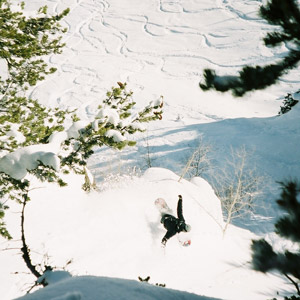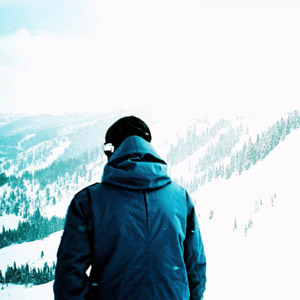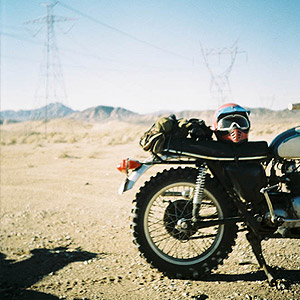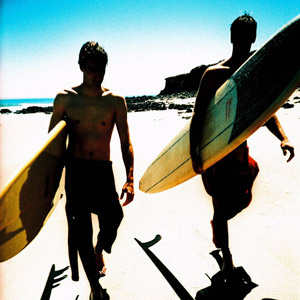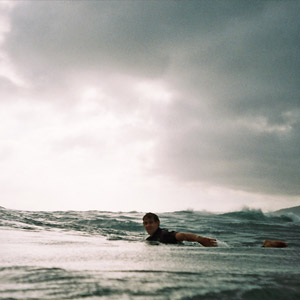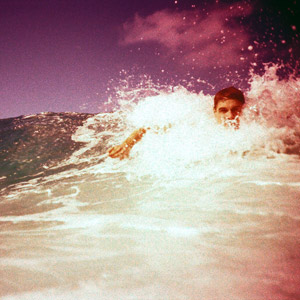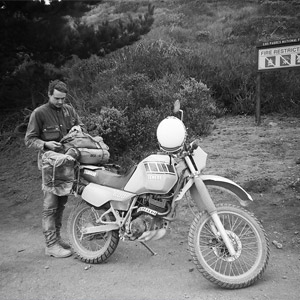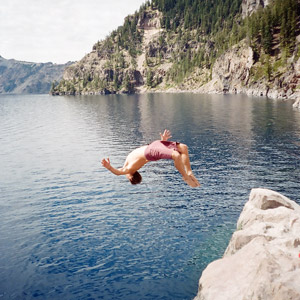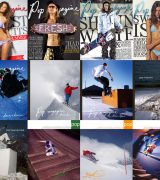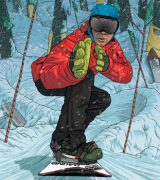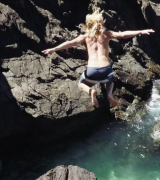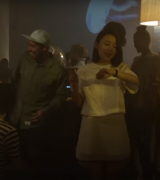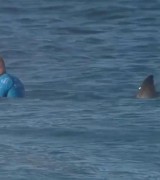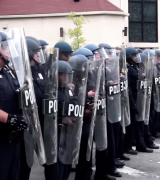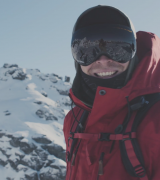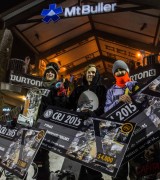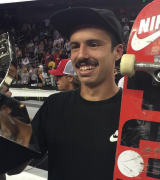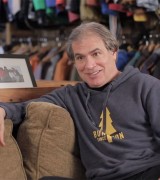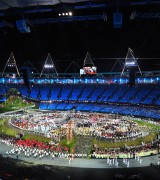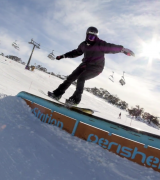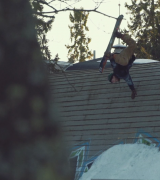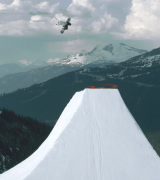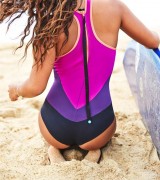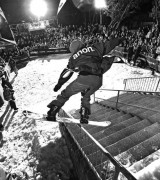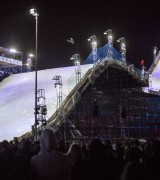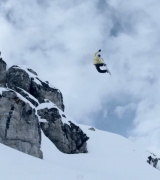In 2005 Dave Keating and I, Rick Baker, set out to create a free press surf, skate and snowboarding magazine. 10 years later, we’re closing the ‘doors’. The whole endeavor was always about capturing the creativity and excitement that surfing, skateboarding and snowboarding gave us and from that, building a community that was inclusive and accessible to everyone.
So with that in mind, I wanted the last post on the Pop website to inspire someone to be creative and start their own thing. Maybe this will help.
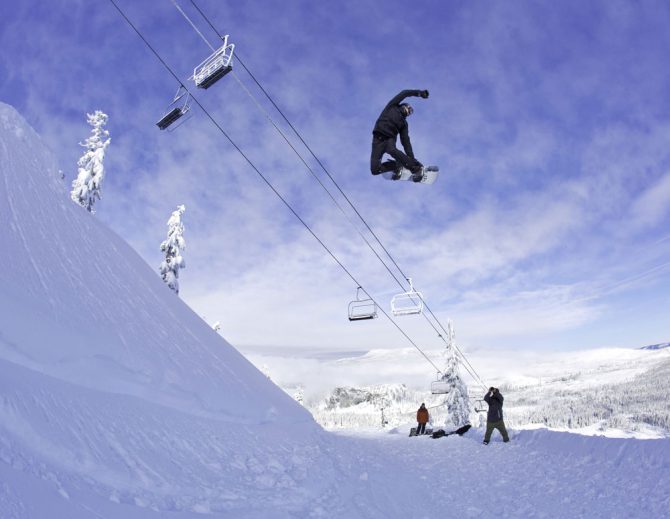
Rick Baker, Method Air, Hoodoo, Oregon, 2015. Photo by Pete Alport.
Getting Started: It Sure Looks Deep, Should I Jump?
When Dave and I started Pop, we knew nothing about making a magazine. I wasn’t a designer, Dave wasn’t a publisher. I got a C+ in English and was failing first-year marketing at university (again), Dave was a real estate salesman. But the other snowboard magazines at the time kinda’ sucked, and we thought a free press ‘zine’ might work.
Think about what you want to do, write a concise business plan of what it is you want to start, and start. It’s very hard to do something like publishing without giving it 100% in my experience. Especially in surf/skate/snow, where you’ve really got to live it. As Ron Swanson says, ‘don’t half-ass two things, whole-ass one thing’.
So we just went for it. I borrowed some money from my parents to pay the printers, downloaded a bootleg version of InDesign, followed some tutorials and copied layouts from other magazines I liked. In hindsight, we tried too much too early. If I did it again, I’d start off as a hardcore street zine. Trying to be polished and newsstand worthy with our skills and experience was very ambitious looking back at it. But that in itself is the attitude you need to have. Optimism that we could do it better. Be disruptive, back yourself and learn quickly.
If you want a partner, find someone that compliments your skills and has the passion for the work. If you’re the creative, find someone that can handle the business side. A passion for the scene is key. You’ve got to believe in what you’re trying to do.
Dave and I were lucky in that we got along. We weren’t great friends or anything before Pop. We knew each other from school. But it turns out Dave had a work ethic greater than anybody and a blind optimism coupled with supreme patience for me and my creative indecision and penchant for procrastinating and going snowboarding.
It’s easy to get caught up in thinking you don’t have enough resources to start. How am I going to print this? Who’s building the website? How am I going to pay contributors? Those are actual problems for sure, but solvable problems.

Dave Keating checking ‘proofs’ at the printers
Editorial Voice
What’s your angle? Are you super positive and stoked on how you are doing this hobby on a board for a living? Are you calling bullshit on the corporatization of ‘our sport’? Are you just trying to be level-headed and sell the dream? Regardless, have a unique voice. Why am I picking up your magazine? Why am I looking at your website? If it’s just for the photos (like I always suspected it was), then own that.
With Pop, we were opinionated. So many magazines treat their readers like idiots. How many ‘trips with the lads’ to Japan could we read? Watered down interviews, terrible product ‘reviews’, half-assed advertising, the same design as last year, editors too scared to say anything remotely controversial, elitist jocks not inviting anyone to the party. Fuck that, snowboarding was never about that for us. We didn’t even put our names in the first few issues. We didn’t want Pop to be about us, we wanted it to be about the people in it. Plus that meant we could take shots at things we thought were funny.
The content that went on the website was exactly the same. We built a ‘shout box’ where anyone could anonymously say whatever they wanted. We wrote articles that asked questions brands really weren’t accustomed to answering. It’s funny how insular surf/skate/snow is. You call out an athlete for selling out, a CEO for buying an expensive house or make a joke about a style and people reacted. We never filtered comments (unless it was straight up bigotry), we encouraged controversy. Pop was free so it wasn’t about selling more magazines, it was about giving the people what they wanted.
Having said that, we felt a responsibility to elevate and steward snowboarding in Australia. So much of it was done half-ass (albeit with good intentions) we thought we should try to be creative wherever possible. Webcasts, premieres, films, fashion shoots, artists, whatever. Just try to be better than what was being done.
Surfing was always tough for us. There’s not a lot of creativity in mainstream surfing. There’s a lot of emphasis on competition and aggression, which really doesn’t gel with snowboarding and skateboarding. Skateboarding kinda’ hates snowboarding, so that was hard to get right too. In hindsight, trying to mix all three sports with the voice we had was probably restrictive from an editorial point of view more than anything.
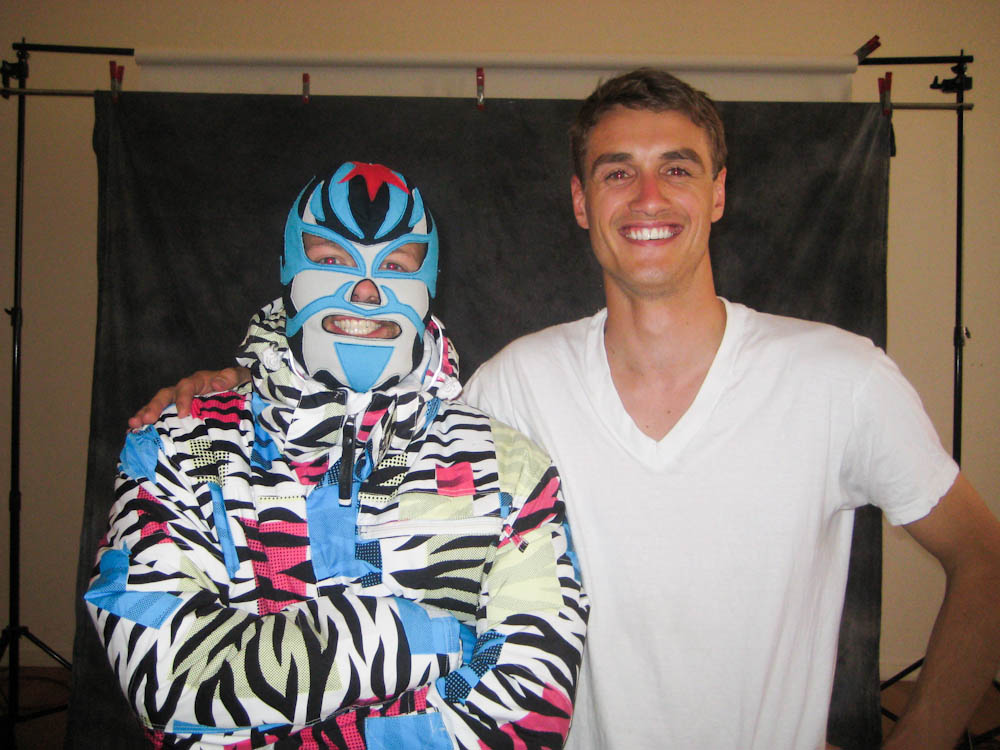
Chris ‘Chunk’ Jepson and Rick Baker on an outerwear shoot
Content
Come up with an editorial formula. Are you doing reviews, interviews, travel stories, photo editorials, lifestyle pieces, short stories?
For us initially, it was only going to be Australian surfers/skaters/snowboarders, with a focus on up-and-coming and underexposed riders/photographers/brands etc. We struggled to learn how to ‘build’ a magazine in the early issues. We hadn’t really thought about how to fill a magazine with all that content every two and a half months. So you do a couple interviews, buy a handful of photos at $200+ a shot. Then what’s the other 40 pages? Reviews? Products?
The late Lewis Marnell, photographed by Liam Kaska, was on our first cover. Later issues, it became harder and harder to find quality Australian stories. Particularly in snowboarding and local surfing. Snowboarding in Australia is just inherently expensive (resorts by and large don’t care about core-magazine coverage) and time limited (three month seasons), and back in the 2005-2010 period, only a handful of photographers were doing good work. So start forming relationships with photographers as quick as you can.
These guys and girls are the lifeblood to what you’re trying to do. Surf/skate/snow is a visual world. You won’t be able to afford big photo trips or even to pay photographers early on, so you need to be creative here. Is your magazine ‘cool’ enough for people to contribute to for their own portfolios? What do they get out of being in your publication? Are you treating their work respectfully? No silly crops, edits, mislabeled captions etc. That stuff matters (I know, I think the first photo I ran I screwed up the caption).
Most photographers charge a usage rate of a couple hundred dollars per photo if it’s running in print. If you’re then using it online, it can get a little tricky. Some magazines demand that’s part of the same rate, but really, in any other industry, it doesn’t matter where it’s used, you should pay them for their work. So you’ll want to figure this out as your content budget per issue will be around $5000 if you’re good. On that, don’t be cheap. You’re running a proper business where people, including you, deserve to get paid.
A lot of international brands have photographers on payroll. So there’s a constant stream of photos coming from international teams available for free and team managers whose job it is to get their riders press. So it becomes really easy to get photos from really good photographers of pros in amazing locations. That just makes getting quality Australia stories all the more harder.
As for all the trip/resort review type stories; when you read a story of an editor and a bunch of snowboarders going to Japan, that’s because the Japanese tourist board has comped a lot of the trip, if not all of it. Same goes for heli trips to New Zealand or any other resort type story. You still have to pay a writer and photographer to go. Getting the snowboarders/skaters/surfers there is another battle entirely…
This was by far our hardest challenge from a content point of view. Producing quality Australian content. I’ll talk from my experience in snowboarding, but it would equally apply to surfing and skateboarding to varying degrees.
Getting photos within Australia is really difficult. The backcountry zones aren’t vast or easily accessible. The crews in NSW have made big pushes to find new zones, but by and large you’re relying on cooperation from resorts for any big stories. This is why so much of Australian snowboarding is rail and park focused, it’s what’s ‘easier’ to do here.
In the northern winter, it should be easier. It’s rare for an Australian pro to have a travel budget, so getting riders to leave their resort base of say Tahoe to come to Utah or Whistler or Europe for a trip is difficult for most. When we made the snowboard movie Two Weeks In, we had to pay for everyone’s tickets, housing, cars etc. It’s really difficult if you use this model.
I would like to say it’s changed now 10 years later, but I think Australian snowboarding has coalesced around rail and park riding even more (with exceptions of international pros like Ryan Tiene, Robbie Walker when he still rode etc). The Go-Pro selfie-stick park lap is the new ‘hike a kicker in the back country’ for sure. I’m not sure if that’s a lack of photographers/videographers or kids just don’t need to be as creative with what they ride because resorts are finally building decent parks in Australia. Kids have gotten better at snowboarding though, I just wonder if the creative media has progressed in the same way?
The lesson we learned with Pop. Quality original content is key to elevating you above the rest. Recognize that as a huge challenge early and work on relationships and approaches for generating that content affordably. Give film crews magazine space for exclusivity, make relationships with resorts and tourism agencies for tickets and resources, keep photographers and riders busy.
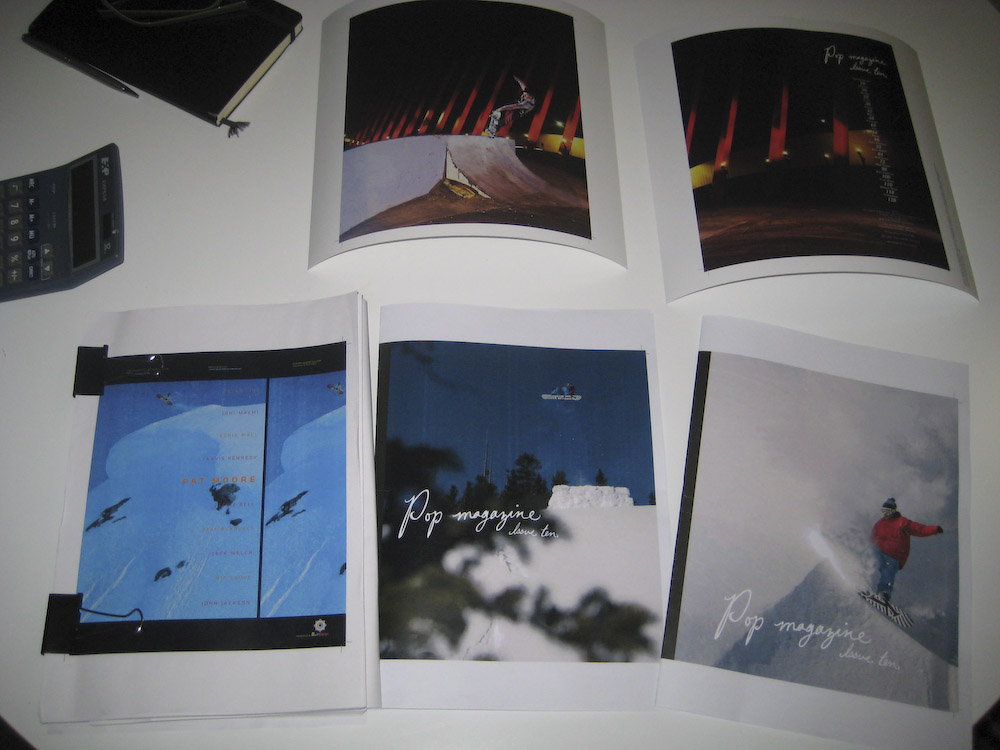
Rick’s favourite, Issue 10. Dual Robbie Walker covers with a Ryan Tiene centerfold.
Design
This is a personal taste thing obviously. We wanted Pop to have large images with lots of whitespace and clean typography. Let the work stand on it’s own and not get too ‘design for designs sake’. That worked well for us considering I was learning how to be a designer every issue. It looks dated now, but it’s always going to. If it doesn’t, you haven’t progressed.
Is your magazine going to be a street-press-photocopied-DIY zine? Is it a serious journal meant to be on a coffee table? Are kids tearing posters out to put on their wall? How thick is the paper? How many pages can you afford?
If you’ve never made a magazine before, find a bootleg copy of Adobe’s InDesign, Photoshop and Illustrator. Start with InDesign, follow every tutorial you need to and start at page one. You’ll figure it out. Remember, to print something nice, it needs to be a minimum of 300dpi (you can push that to 240dpi if you need to). You won’t know what DPI is yet. Look it up, it’s very important.
Go to a magazine stand and buy all the cool magazines you can, sit them on your desk and copy every layout you like. Soon you’ll figure it and find your own style. Australia has a really rich magazine landscape, you’ll get creative quick.
Pop live webcast the Forum and Burton rail jam events.
Online
I’ve spoken a lot about print, but your online presence is equally important. That’s right, equally. If you’re in surf/skate/snow, having a magazine that you can actually afford to make is a huge bonus I think. This industry still values print. However, if you don’t have a website (and know how to use/sell it), you’ll struggle.
Build it on the WordPress CMS. I now build websites for a living, just trust me on this. You can find tutorials for everything, most developers are familiar with it so hiring someone if you can’t do it yourself is easy, there are a lot of free tools out there. It’s powerful and easy to work with. We got talked into using something else at one stage and we never recovered.
What original content can you produce for the site? Just reposting news from Transworld isn’t going to bring you a lot of traffic. Likewise, the saying is ‘tits get the clicks’ so if you’re just chasing big traffic numbers, that can be a race to the bottom in terms of content quality. So you have to find content that draws an audience. For Pop, it was things like our movie projects where people could follow the riders and the content that that created, the movie premieres and all the party photos, Monday morning news stories and videos or a controversial comment thread.

Being seen at industry events is important.
Advertising
Everyone wants to get paid. You included. So you have to figure out a way to pay contributors, printers, distribution and whatever else.
For print, it’s your first issue so you will struggle to sell advertising. In fact, just getting reputable brands to advertise for free will be difficult. So have a plan to withhold advertising until THEY know you have a quality product. Advertisers all know that a week before printing magazines will fire-sale advertising rates to try and fill empty pages. Avoid this as much as you can, it makes it really hard to raise prices later on. The reality is, no matter how cool your magazine is or how many you print, it’s a full time job to sell advertising and chase payment. Find someone who likes making deals and pay them a big commission to be your sales person. They are worth their weight in gold.
Dedicate serious effort into collecting payment from advertisers. How the payment ecosystem works goes against you. Brands buy the product form the US, sell it into shops months later. Shops then don’t pay the brands for 90 days, which means you’re not going to get your money until basically all the product which is being advertised has sold. Avoid being a victim to this anyway you can.
Getting artwork form advertisers is always a battle. Australia brands are nearly all just distributors for US brands. So most of the time, artwork has to come from art departments in the US. Which takes weeks to turn around.
There are all kinds of sales strategies for selling print ads. Sign companies to year long deals so they know what seasons and products to advertise whilst guaranteeing editorial space. Yes, that’s right. Even in a fiercely independent free press magazine like Pop, there was always pressure to review this product or feature that rider. You’re always trying to balance editorial integrity with appeasing advertisers. We’re not a newspaper, none of us considered ourselves journalists. We just wanted to be able to print the next issue. You’ll have to be able to balance the demands of your readers, advertisers and creative integrity.
The price per page is supposed to be based on ‘reach’, which is really just how many issues you print. This whole numbers game is a joke in the Australian magazine world. No one prints how many they say they do. There are independent auditing agencies that verify how many you print. Pop did it. No one cared, it didn’t help our ad sales or the amount we could charge. Brands care about cool factor and buzz. If industry people are talking about it, if it’s sitting on their desk, are people talking about it? I would go so far as to say print as few as you think you can get away with. Until brands show they care about reach, why would you do it differently?
As for online advertising, it’s constantly changing. We used to get paid per 1000 impressions. Meaning for every 1000 times an ad unit on the website was viewed, we’d get twenty dollars or whatever you could negotiate. Again, it’s a sales thing and you’ve got to be really good at chasing and building these deals. It’s very important. As I said above, if you’re not a sales person, hire one! I’m not sure traditional display advertising is the way to make money online. It just seems like a print persons answer.
Are you charging for digital content? When we started, that was a no-no, especially when the magazine was free. But people are more accustomed to paying for things now. iTunes, Spotify, NetFlix, Apps etc. A subscription model might be easier than relying on traditional display advertising.
I think ‘integrated advertising’ makes a lot more sense for ‘action sports’. Photos and mentions in stories, short videos with sponsored riders, promotion of events, exclusive content arrangements, trips etc. Sure logo placement and overall ‘brand awareness’ is important, but I wouldn’t rely on that form of advertising, you’re never going to be Facebook in terms of traffic, so don’t try to be that. Use your strengths in audience access and credibility. That’s what you have that’s really valuable.
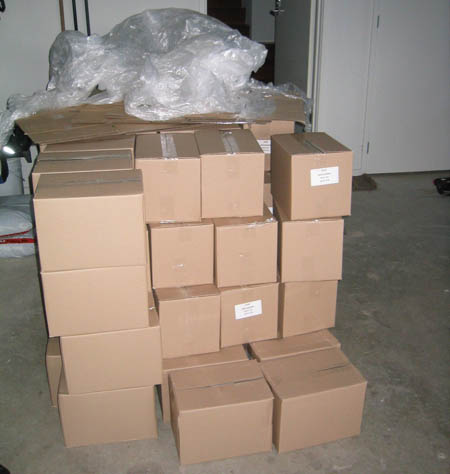
Dave and I actually handed these out at Flinders St Station.
Printing & Distribution
We gave Pop away for free. That’s a tough way to make money.
Now because Pop was free, there was an argument that it didn’t hold as much ‘value’ in readers minds. So there was always pressure to increase the quality of Pop. We ended up with a full gloss magazine that was thicker with less advertising per content piece than the entire industry. That was absurd considering we were giving it away and paying the same contributors the same rates. If you go free, be careful of this.
Our first issues of Pop were twice as expensive as later issues. Printers are a slimy lot. There is so much room to negotiate on pricing. They own these factories and need to keep the presses rolling constantly. They need your business. There are a lot of printers, play them off against each other. Then work with the pre-press teams at the printers to have them teach you how to deliver your files. For us, we wanted an 80 pages magazine on decent weight paper to cost under a dollar a copy.
Yes printing overseas is way cheaper. But when we were making the magazine, there were often 6 week lead times plus whatever customs decided to add on to that. We were never that far ahead in design or content deadlines, the opposite actually. Another thing to keep in mind is where is all that paper coming from? It was important to Pop that the paper be environmentally sustainable.
As for distribution, a side effect of being free meant we could make a smaller magazine and put it in every surf/skate/snow shop that actually sold the products that were being advertised in Pop. Our aim was to have a copy going home with every purchase. In hindsight, I’m not sure how much value brands put on that (the smart ones did). It was really difficult to courier heavy boxes of magazines to regional surf/skate/snow shops where it might just end up in the dumpster. We were paying tens of dollars per box sometimes.
A more traditional newsagency approach might be easier and give you a legitimacy that might make selling advertising easier. It really just depends on how you want to get your magazine out there. We never charged for the magazine, so I don’t know how those traditional distribution models work. There are companies that handle the shipping and returning of mastheads that don’t sell and you settle up with them for total sales etc. We never dd it but you can figure it out.

Ralph, Rick and Shane at Robbie Walker’s ‘Nice Try’ premiere event.
The Industry
One of the main reasons Pop had early support was because of our personal relationships with people working in the industry. That support was instrumental. From shops, to brand managers to riders and photographers. It just meant that we had an inside track on news and events, support and encouragement from advertisers and riders keen to be involved. So don’t forget that while you’re now busy working on a magazine 20 hours a day, you still need to be at the contests, down the surf, at the parties, visiting shops. The industry thrives on passion and dedication.
That being said, there’s a lot of friends hooking up friends which means you’re not always going to be able to reason with a marketing manager about why your traffic analytics are so great. They might not even know how to read those numbers, or even care. More than likely they’ve been mates with that other editor forever and your magazine just isn’t that cool to the people they know. The people in action sports aren’t there because it pays well, the career path is solid or the job required an education, they’re there because they loved it more than anyone else.
I will say this though, being removed from the snowboard world for a couple years now, I miss the passion. For 15 years all I wanted to do was save money to go snowboarding on some mountain with my friends. But you need to be passionate to work in this industry, so if you ever lose that, make sure you’ve got a plan to give what you’ve created to someone else to carry it forward and keep it fresh. You do get older, then you start wanting a ‘real job’, you get over hyping kids doing tricks on bits of wood. But what I didn’t expect was that’s kinda’ what’s supposed to happen. The industry relies on youth, disruption, change. So plan for it.
With that, Dave and I want to thank everyone who supported Pop Magazine over the years. The core group know who you are and we couldn’t have done it without you all. All of us put a lot of energy into it. I hope that we’ve inspired someone to pick up a board and have fun.
Any questions, email me.
Rick Baker, Creative Director, Pop Magazine.


